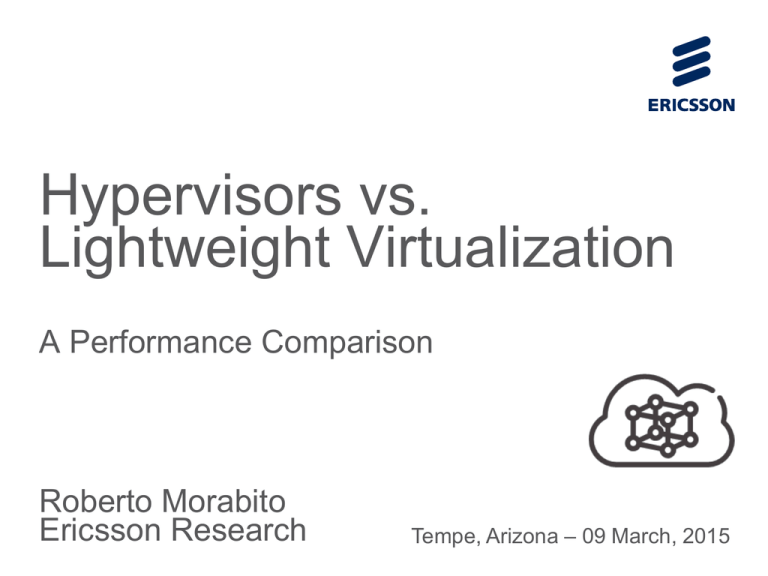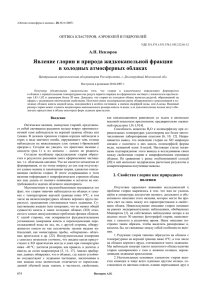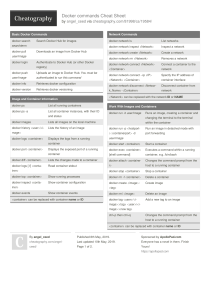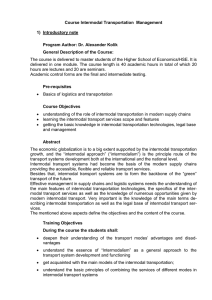Hypervisors vs. Lightweight Virtualization
advertisement

Hypervisors vs. Lightweight Virtualization A Performance Comparison Roberto Morabito Ericsson Research Tempe, Arizona – 09 March, 2015 Outline › Introduction › Hypervisors, Containers, other solutions › Methodology and Experimental Setup › Benchmark Results › Conclusions › Future Work Hypervisors vs. Lightweight Virtualization: a Performance Comparison | First International Workshop on Container Technologies and Container Clouds| 2015-03-09 | Page 2 Introduction › Motivation: – Usage of Virtualization in others context such as Cloud Environments, Internet of Things, Network Function Virtualization. – Hypervisors reduced overhead – Lightweight Virtualization claim to offer superior performance › Container-based Solution became very popular › Other emerging solutions are gaining prominence › Goal: – Quantify level of overhead – Understand strengths, weaknesses, and anomalies of different platforms Hypervisors vs. Lightweight Virtualization: a Performance Comparison | First International Workshop on Container Technologies and Container Clouds| 2015-03-09 | Page 3 Introduction Container-based Virtualization Architecture › Lightweight alternative to hypervisor-based virtualization › Containers implement isolation of processes at the OS level › Run on top of the same shared OS kernel of the underlying host machine › Higher density of virtualized instances › Containers do not isolate resources as well as hypervisors LXC Hypervisors vs. Lightweight Virtualization: a Performance Comparison | First International Workshop on Container Technologies and Container Clouds| 2015-03-09 | Page 4 Introduction Hypervisor-based Virtualization Architecture › Hypervisors operate at the hardware level supporting standalone VM that are independent and isolated from the host system – Trade-off: a full OS is installed to the VM larger image – Emulation of virtual hardware devices incurs more overhead Hypervisors vs. Lightweight Virtualization: a Performance Comparison | First International Workshop on Container Technologies and Container Clouds| 2015-03-09 | Page 5 Introduction Alternative Virtualization Architecture › OSv: dedicated OS designed exclusively for the Cloud Computing – OSv is intended to be run on top of a hypervisor (KVM, Xen, Virtual Box, etc.) – It achieves the isolation benefits of hypervisorbased systems, but avoids the overhead of the Guest OS – OSv applications can be built and executed via the Capstan tool that is conceptually similar to Docker – Several issues especially concerning software portability/compatibility Application Minimal lib. OS (e.g. OSV) Hypervisor (e.g. KVM) Host OS (Linux) Hardware OSv “Stack” Hypervisors vs. Lightweight Virtualization: a Performance Comparison | First International Workshop on Container Technologies and Container Clouds| 2015-03-09 | Page 6 Methodology Experimental Setup › Host machines – Computer Model: Dell Precision T5500 – Processor: CPU Intel Xeon X5560@ 2.80GHz, 4 cores (8 threads) – RAM Memory: 12 GB (3x4GB) 1333 MHz DDR3 – Disk: OCZ-VERTEX 128GB SSD – Network Interface:10-Gigabit NIC (Dual Port) – OS: Ubuntu 14.04 LTS › › › › › › Hypervisor, containers, OSv – – – – KVM (QEMU emulator version 2.0.0) LXC 1.0.6 Docker 1.3.2 OSv 0.15 KVM is managed using the standard Linux libvirt API and toolchain (virsh) OSv is running over KVM LXC and Docker are running directly over the host OS Linux Guest OS on KVM is Ubuntu 14.04 (64bit) Individual measurements are repeated at least 15 times › General benchmarking – Real Systems are usually different from our basic environment – Real Application and their workloads are different than generic benchmarking tools Hypervisors vs. Lightweight Virtualization: a Performance Comparison | First International Workshop on Container Technologies and Container Clouds| 2015-03-09 | Page 7 Benchmark Results › CPU › Disk I/O › Memory › Network I/O LXC Hypervisors vs. Lightweight Virtualization: a Performance Comparison | First International Workshop on Container Technologies and Container Clouds| 2015-03-09 | Page 8 CPU Performance › Benchmark tools: – Y-cruncher – NBENCH – Geekbench – noploop – Linpack LXC LXC Hypervisors vs. Lightweight Virtualization: a Performance Comparison | First International Workshop on Container Technologies and Container Clouds| 2015-03-09 | Page 9 CPU Performance › Y-cruncher – Multi-threaded benchmark tool – Pi calculation – Better than other similar alternatives (super-Pi etc.) Pi Computation Hypervisors vs. Lightweight Virtualization: a Performance Comparison | First International Workshop on Container Technologies and Container Clouds| 2015-03-09 | Page 10 CPU Performance › Y-cruncher – Multi-threaded benchmark tool – Pi calculation – Better than other similar alternatives (super-Pi etc.) Multi-core Efficiency Hypervisors vs. Lightweight Virtualization: a Performance Comparison | First International Workshop on Container Technologies and Container Clouds| 2015-03-09 | Page 11 CPU Performance › NBENCH – Single-threaded benchmark tool – 10 algorithms – Three different Index are provided NBENCH Index Hypervisors vs. Lightweight Virtualization: a Performance Comparison | First International Workshop on Container Technologies and Container Clouds| 2015-03-09 | Page 12 CPU Performance › noploop – Very simple tool – Very easy OSv porting noploop output Hypervisors vs. Lightweight Virtualization: a Performance Comparison | First International Workshop on Container Technologies and Container Clouds| 2015-03-09 | Page 13 CPU Performance › Linpack – Two variants – System performance are tested using a simple linear algebra problem – Result is given in MegaFLOPS Hypervisors vs. Lightweight Virtualization: a Performance Comparison | First International Workshop on Container Technologies and Container Clouds| 2015-03-09 | Page 14 CPU Performance › Linpack result with varying matrix dimension – Three different “regions” can be detected – OSv presents some performance degradation (for low N values) Hypervisors vs. Lightweight Virtualization: a Performance Comparison | First International Workshop on Container Technologies and Container Clouds| 2015-03-09 | Page 15 Disk I/O Performance › Benchmark tools: – Bonnie++ – IOzone – Sysbench – dd LXC Hypervisors vs. Lightweight Virtualization: a Performance Comparison | First International Workshop on Container Technologies and Container Clouds| 2015-03-09 | Page 16 Disk I/O Performance ≈11% › Bonnie++ › Not supported by OSv › Test file size: 25 Gib › Results for Mixed test: – KVM disk throughput achieves the worst performance – LXC is still performing slightly better than Docker (4% faster) Hypervisors vs. Lightweight Virtualization: a Performance Comparison | First International Workshop on Container Technologies and Container Clouds| 2015-03-09 | Page 17 Disk I/O Performance ≈35% › Bonnie++ › Not supported by OSv › Test file size: 25 Gib › Results for Random Seek measurement: – The order of the platforms is the same – LXC is performing now quite much better than Docker (approximately 35%) – KVM has a very poor performance Hypervisors vs. Lightweight Virtualization: a Performance Comparison | First International Workshop on Container Technologies and Container Clouds| 2015-03-09 | Page 18 Disk I/O Performance › Results for Disk I/O measurements: – Mismatch between the results of Bonnie++ and other tools (Sysbench and IOzone) – Other works[X] confirm unusual results – No material that compares/evaluates Disk I/O benchmarking tools reliability › Alternative Disk I/O evaluation using Unix-like command dd: – It is used for several things: recovering data, backing up function, data conversion etc. – We use dd to read and write from special device files (/dev/zero/) – Test file size of 50 Gib – Block size (512 and 1024 bytes) [X] Estrada, Zachary J., et al. "A Performance Evaluation of Sequence Alignment Software in Virtualized Environments." Cluster, Cloud and Grid Computing (CCGrid), 2014 14th IEEE/ACM International Symposium on. IEEE, 2014. Hypervisors vs. Lightweight Virtualization: a Performance Comparison | First International Workshop on Container Technologies and Container Clouds| 2015-03-09 | Page 19 Disk I/O Performance Platform Disk I/O speed Native 122 MB/s LXC 92 MB/s Docker 113 MB/s KVM 49.8 MB/s › dd (average over 20 run) results show: – Bonnie++ results are approximately confirmed – Native, KVM, and LXC obtained always the same output (without any valuable deviation) – Docker was performing (for few run) better than Native distribution (135 MB/s) Hypervisors vs. Lightweight Virtualization: a Performance Comparison | First International Workshop on Container Technologies and Container Clouds| 2015-03-09 | Page 20 Memory Performance › Benchmark tools: – STREAM LXC Hypervisors vs. Lightweight Virtualization: a Performance Comparison | First International Workshop on Container Technologies and Container Clouds| 2015-03-09 | Page 21 Memory Performance › STREAM Test – It measures memory performance using very simple vector kernel operations. – Strong dependency to the CPU cache size Big Stream Array Operation Kernel Copy x[i] = y[i] Scale x[i] = q * y[i] Add x[i] = y[i] + z[i] Triad x[i] = y[i] + q * z[i] Hypervisors vs. Lightweight Virtualization: a Performance Comparison | First International Workshop on Container Technologies and Container Clouds| 2015-03-09 | Page 22 Memory Performance › Results for STREAM memory test: – KVM, Docker, and LXC all reach performance similar to the native execution – OSv introduces a considerable gap compared with the other platforms Hypervisors vs. Lightweight Virtualization: a Performance Comparison | First International Workshop on Container Technologies and Container Clouds| 2015-03-09 | Page 23 Network Performance › Network performance evaluation – Experimental setup: – Two identical hosts directly connected with 10 Gigabit Ethernet Link – Netperf benchmark tool is used – One host is running netperf client and the other netperf server – netperf server is running on the tested platform – 60 seconds each test – TCP_STREAM, TCP_RR, UDP_STREAM, UDP_RR – IPv4 addresses Client Server Hypervisors vs. Lightweight Virtualization: a Performance Comparison | First International Workshop on Container Technologies and Container Clouds| 2015-03-09 | Page 24 Network Performance › Benchmark tools: – Netperf – Iperf LXC Hypervisors vs. Lightweight Virtualization: a Performance Comparison | First International Workshop on Container Technologies and Container Clouds| 2015-03-09 | Page 25 Network Performance › TCP_STREAM Test ≈28% ≈26% – Default test in netperf – Simple TCP data transmission between client and server › Results for TCP_STREAM test: – Docker and LXC achieve almost equal performance compared to Native – KVM is 28.41% slower than the non-virtualized environment – OSv is faster than KVM, but the gap compared to Native is still high (26,46%) Hypervisors vs. Lightweight Virtualization: a Performance Comparison | First International Workshop on Container Technologies and Container Clouds| 2015-03-09 | Page 26 Network Performance › TCP_RR (Request and Response) Test ≈47% ≈19% – Calculate the number of TCP transactions (request and response) exchanged between client and server › Results for TCP_RR test: – Docker and LXC introduce a moderate level of overhead (19.36% and 17.35%) – KVM offers the lowest result (47,35% slower than native) – OSv performs better than KVM (roughly 4% faster) Hypervisors vs. Lightweight Virtualization: a Performance Comparison | First International Workshop on Container Technologies and Container Clouds| 2015-03-09 | Page 27 Network Performance › UDP_STREAM Test – UDP is used as transport protocol – Simple UDP data transmission between client and server ≈43% ≈42% › Results for UDP_STREAM test: – All platforms offer lower throughput with UDP – KVM overhead is the largest (54.35%) – OSv is faster than KVM, but the gap compared to Native is still large (46,88%) Hypervisors vs. Lightweight Virtualization: a Performance Comparison | First International Workshop on Container Technologies and Container Clouds| 2015-03-09 | Page 28 Network Performance › UDP_RR Test ≈11% – Calculate the number of UDP transactions (request and response) exchanged between client and server › Results for UDP_RR test: – Similar results with the TCP_RR test – Compared with Native: Docker 12,13% slower, LXC 10,82% slower OSv 43,14% slower, KVM 45,76% slower Hypervisors vs. Lightweight Virtualization: a Performance Comparison | First International Workshop on Container Technologies and Container Clouds| 2015-03-09 | Page 29 ≈43% Conclusions › Container-based solutions and others emerging systems are challenging traditional hypervisor based virtual machines in cloud computing › Lightweight technologies deployment of instances facilitate a more dense › Hypervisors performance have dramatically improved during the last few years – Disk I/O efficiency can represent still a bottleneck for some types of applications Hypervisors vs. Lightweight Virtualization: a Performance Comparison | First International Workshop on Container Technologies and Container Clouds| 2015-03-09 | Page 30 Conclusions › Level of overhead introduced by containers can be considered almost negligible – Versatility and ease of management is paid in terms of security › Network efficiency represent an important open issue for all solutions (especially UDP traffic) › OSv represents an interesting work-in-progress alternative although it introduces some limitations in terms of software portability Hypervisors vs. Lightweight Virtualization: a Performance Comparison | First International Workshop on Container Technologies and Container Clouds| 2015-03-09 | Page 31 Future Work › Next Steps: – Energy Efficiency and Power Consumption analysis – Container monitoring and Resource Management – Further investigations into OSv, ZeroVM, Rocket, LXD, Snappy Ubuntu, Project Atomic, CoreOS etc. – Microbenchmarking – Paravirtualization (e.g. Xen) – Performance evaluation using specific workloads –… Hypervisors vs. Lightweight Virtualization: a Performance Comparison | First International Workshop on Container Technologies and Container Clouds| 2015-03-09 | Page 32







